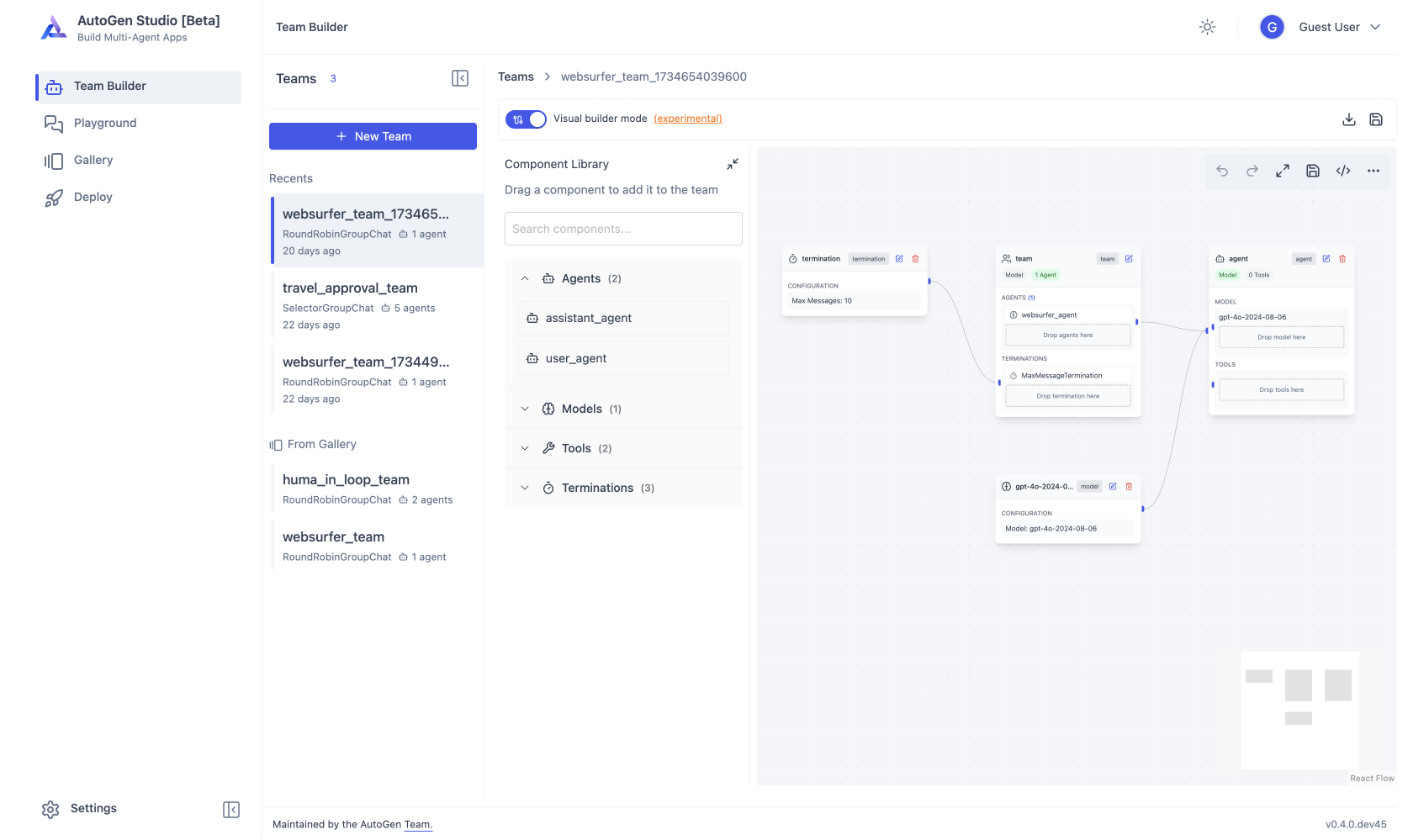AutoGen is Microsoft's open-source framework for building AI agents that can collaborate, call tools, and even form teams - without making developers choose between speed and control. Housed in the microsoft/autogen repository, the project tackles a fast-emerging need: making multi-agent systems practical, composable, and debuggable for real-world workflows. If you've been watching the evolution from single LLM prompts to orchestration, AutoGen is the bridge that turns experiments into applications.
microsoft
Organization
autogen
A programming framework for agentic AIThe Problem & The Solution
As teams prototype agentic features - planning, tool use, web browsing, code execution - they hit the usual wall: brittle one-off implementations, unclear boundaries between components, and difficulty moving from a laptop proof-of-concept to a distributed runtime. AutoGen answers with a layered architecture that cleanly separates concerns.
The autogen-core package provides an event-driven runtime based on the actor model. On top, autogen-agentchat offers approachable, opinionated APIs for rapid prototyping. And autogen-ext brings first- and third-party extensions - from model clients like OpenAI and Azure OpenAI to capabilities like code execution. The result: you can start simple and scale up, without swapping frameworks mid-journey.
Key Features
- Layered design: Core runtime (autogen-core), high-level APIs (autogen-agentchat), and extensibility (autogen-ext) form a clear separation of concerns.
- Multi-agent orchestration: Compose teams and patterns (two-agent chats, group chats) with the AgentChat API; scale out with the Core runtime.
- MCP integration: Built-in
autogen-extsupport for Model Context Protocol (MCP) servers enables agents to safely access external tools and data sources via a common standard (MCP Team, 2024).- No-code prototyping: AutoGen Studio lets you assemble workflows and iterate quickly in a browser.
- Evaluation and examples: AutoGen Bench provides a way to measure agent performance; the repo ships comprehensive samples in the README and package docs.
Why I Like It
What stands out is the practical composition story. The project makes multi-agent orchestration feel modular: agents expose capabilities, tools can be packaged as components, and teams become reusable workflows. The developer experience also feels deliberately modern - live streaming, console utilities, and a no-code GUI via AutoGen Studio - so you can validate ideas quickly and then harden them with the lower-level core when needed.
from autogen_agentchat.agents import AssistantAgent
from autogen_ext.models.openai import OpenAIChatCompletionClient
model_client = OpenAIChatCompletionClient(model="gpt-4.1")
agent = AssistantAgent("assistant", model_client=model_client)
print(agent.run(task="Say 'Hello World!'")) Under the Hood
The Core adopts the actor model for concurrency: agents communicate by exchanging messages over topics, enabling local development that can later move to distributed deployment. That design supports resilience (agents can fail independently), scalability (more agents and topics), and composability (subscriptions wire components together).
The AgentChat layer packages common patterns - assistants, tools, and group chats - so you can get to a working prototype in minutes. Extensions live in autogen-ext, where model clients and tools (including MCP) plug into a consistent interface.
At the heart of autogen-core lies the RoutedAgent architecture. This base class uses Python decorators to create type-safe message routing - @rpc for request-response patterns and @event for fire-and-forget messaging. The system automatically discovers handlers at runtime, making agent communication both declarative and debuggable. For example, when one agent needs data from another, it can make an RPC call that's type-checked and automatically routed to the correct handler method.
The OpenAI client implementation showcases production-ready patterns: streaming responses with proper async/await handling, structured output support for tool calling, and comprehensive error handling for rate limits and model availability.
The client supports vision models, function calling, and even token counting - essential for cost management in production deployments. This isn't just a wrapper around the OpenAI API; it's a carefully designed abstraction that works consistently across different model providers through the common ChatCompletionClient interface.
The repository structure reflects this layered philosophy. Under python/packages/, you'll find autogen-core handling the runtime, autogen-agentchat providing high-level APIs, autogen-ext offering model integrations, autogen-studio delivering the no-code experience, and agbench enabling performance evaluation.
There's also a .NET implementation that maintains architectural alignment, plus emerging TypeScript support. The examples directory contains practical Jupyter notebooks demonstrating company research, literature reviews, and travel planning - real applications you can run and modify.
Real-World Challenges & Community Solutions
Like any evolving framework, AutoGen faces real deployment challenges that the community actively addresses. Users report integration complexities with various model providers - from SSL certificate issues with MCP tools to compatibility challenges with local models like Qwen and Gemini.
The community response has been notably collaborative: contributors share configuration patterns, Microsoft engineers provide detailed troubleshooting guidance, and the architecture's modular design enables workarounds without framework changes.
A particularly interesting development is the community's push for better discoverability of AutoGen applications. GitHub discussions reveal users building everything from automation engines to specialized research tools, but finding and sharing these implementations remained challenging. Microsoft's response: a proposed gallery system where developers can showcase their AutoGen applications, complete with descriptions, screenshots, and deployment guides. This kind of feedback loop - community identifies friction, maintainers respond with infrastructure - demonstrates the project's commitment to practical usability over theoretical perfection.
Use Cases
AutoGen shines in scenarios requiring structured collaboration among AI components. The framework supports everything from research assistants that browse and cite sources to customer support triage agents that call internal systems, developer copilots that write and test code, and data teams that coordinate retrieval, transformation, and reporting workflows.
Real-world implementations showcase the framework's versatility. Community member @lordlinus built a travel chatbot using autogen-core's routing agent architecture, demonstrating how the actor model scales for customer-facing applications.
The AutoGen examples include company research workflows that combine web browsing with document analysis, and literature review automation that helps researchers efficiently process academic papers. Microsoft's own solution accelerators demonstrate enterprise patterns for document processing, conversational AI, and business automation.
With MCP integration, agents can seamlessly connect to an expanding ecosystem of servers - local files, search engines, calendars, cloud APIs, and more - without custom integration code each time (MCP Team, 2024).

The Studio experience makes these complex workflows accessible to non-specialists while giving engineers powerful observability and debugging tools. Whether you're building internal automation or customer-facing applications, AutoGen's architecture supports both rapid prototyping and production deployment.
Community & Contribution
AutoGen maintains an active, welcoming community with multiple contribution pathways. Start with CONTRIBUTING.md for technical guidelines, join the Discord for real-time discussions, and browse GitHub Discussions for Q&A and feature requests. Microsoft's engineering team hosts regular office hours and publishes development updates on the AutoGen blog.
For newcomers upgrading from v0.2, the migration guide is essential reading - the v0.4 redesign represents a significant architectural shift. The project's release cadence shows consistent progress, with monthly updates and careful attention to breaking changes. Recent community contributions include model provider integrations, MCP server implementations, and expanded example notebooks covering domains from financial analysis to scientific research. The maintainers particularly welcome contributions to documentation, example applications, and integration with emerging AI tools and platforms.
Usage & License Terms
AutoGen's repository uses dual licensing: documentation and non-code content under CC BY 4.0, and software under the MIT License. In practice: you can use, modify, and redistribute the code with attribution and the MIT notice; and you can reuse docs/content with attribution under Creative Commons. As always, review third-party components you add via extensions to ensure their terms are compatible with your deployment model.
Impact & What Comes Next
Agentic apps are moving from novelty to necessity. AutoGen's layered approach, MCP support, and Studio tooling make it a credible path from notebook to production. Microsoft has also signaled alignment between the autogen-core runtime and Semantic Kernel for enterprise developers, pointing to deeper compatibility in 2025 ( Niedtner, 2024 ).
You can explore Semantic Kernel itself here: microsoft/semantic-kernel. Expect tighter integrations with orchestration, better evaluation tooling, and a growing library of MCP servers and extensions.
About Microsoft
Microsoft is a global technology company that builds software, services, and devices for consumers and enterprises. The company actively maintains open-source projects across AI, cloud, and developer tools, with technical updates published on Dev Blogs and documentation on Microsoft Learn. AutoGen is developed in the open by Microsoft engineers and community contributors.
Conclusion
If you want to build multi-agent systems that can browse, plan, code, and collaborate, AutoGen gives you the pieces to start fast and grow safely. Explore the repository, try the quickstarts in README.md, and kick the tires with AutoGen Studio. Whether you are a solo developer or an enterprise team, the layered design means you do not have to pick between productivity and power - you can have both.
Ready to Move from Concept to Production?
Exploring frameworks like AutoGen shows just how fast agentic AI is evolving. The leap from simple prompts to collaborative, multi-agent workflows is massive, and it's the key to building the next generation of applications. But harnessing this power requires more than just installing a new library; it demands a robust architecture and deep integration expertise.
That's what I've spent two decades mastering. With over 20 years as a solutions architect, I've partnered with organizations of all sizes to build and scale their most ambitious software platforms. If you have an idea for an AI-driven workflow and want to see it move from concept to a secure, scalable production system, let's have a conversation about building it right.


AutoGen: Microsoft's Agent Framework, Reimagined for Multi-Agent Workflows